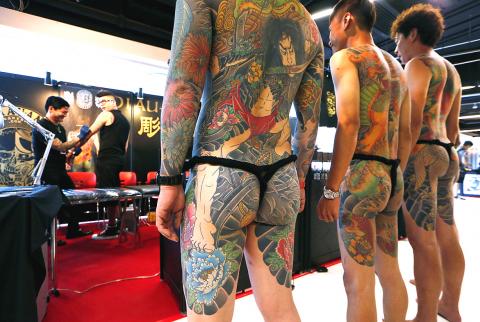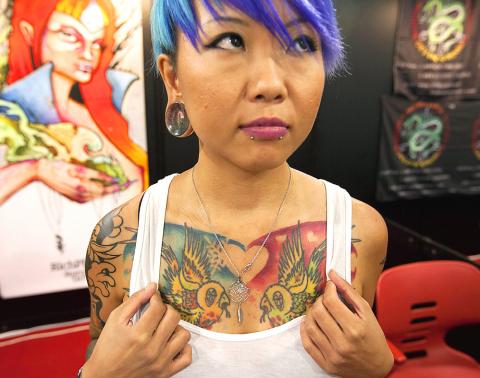Visitors flocked Friday to a Hong Kong tattoo convention, the first to be held in the southern Chinese city where tattoos were once seen as a sign of triad gang membership.
The show features more than 30 artists from countries ranging from South Africa to mainland China.
It aims to challenge “that old-fashioned notion that it’s just gangsters and sailors” who get tattoed, co-organizer Jay Foss Cole told AFP.

Photo: EPA
Hong Kong’s lawyers, doctors and university professors all sport the skin designs, said Foss Cole, also known as Jay FC, and they also appeal to people in creative industries.
Visitors, many of whom wore revealing clothing to display their own prized body sketches, browsed through designs, chose new ones and checked out different marking pens and techniques.
Spectators were awestruck by the sight of four near-nude male models showcasing their colorful full-body tattoos in Japanese style.

Photo: EPA
“I got mine because I love it,” said one of the models.
The work took 12 hours.
Others sprawled on the beds or chairs of tattoo artists and watched intently as intricate designs were inked onto their skin.
Historically tattoos on younger Chinese have largely been the preserve of triad gangsters, but the designs have begun to gain popularity among the mainstream community in recent years.
“Young people are changing their minds, not like before when they thought only mafia members wore them. Now it’s more like art,” Beijing-based tattoo artist Qi Xulong, known as “Little Dragon,” told AFP.
“Long time ago, Chinese people in Beijing and Shanghai, they don’t think that tattoos are good,” Qi said, adding that now people increasingly use tattoos to express their identities.
Foss Cole said Hong Kong’s tattoo culture is improving. “There’s more artists, there’s better artists, there’s more style, and there’s never been anything like this,” he said of the show.
The convention, said Foss Cole, shows that Hong Kong “has arrived as a world-class destination for tattoos and tattoo artists.”

Feb. 17 to Feb. 23 “Japanese city is bombed,” screamed the banner in bold capital letters spanning the front page of the US daily New Castle News on Feb. 24, 1938. This was big news across the globe, as Japan had not been bombarded since Western forces attacked Shimonoseki in 1864. “Numerous Japanese citizens were killed and injured today when eight Chinese planes bombed Taihoku, capital of Formosa, and other nearby cities in the first Chinese air raid anywhere in the Japanese empire,” the subhead clarified. The target was the Matsuyama Airfield (today’s Songshan Airport in Taipei), which

On Jan. 17, Beijing announced that it would allow residents of Shanghai and Fujian Province to visit Taiwan. The two sides are still working out the details. President William Lai (賴清德) has been promoting cross-strait tourism, perhaps to soften the People’s Republic of China’s (PRC) attitudes, perhaps as a sop to international and local opinion leaders. Likely the latter, since many observers understand that the twin drivers of cross-strait tourism — the belief that Chinese tourists will bring money into Taiwan, and the belief that tourism will create better relations — are both false. CHINESE TOURISM PIPE DREAM Back in July

Could Taiwan’s democracy be at risk? There is a lot of apocalyptic commentary right now suggesting that this is the case, but it is always a conspiracy by the other guys — our side is firmly on the side of protecting democracy and always has been, unlike them! The situation is nowhere near that bleak — yet. The concern is that the power struggle between the opposition Chinese Nationalist Party (KMT) and their now effectively pan-blue allies the Taiwan People’s Party (TPP) and the ruling Democratic Progressive Party (DPP) intensifies to the point where democratic functions start to break down. Both

This was not supposed to be an election year. The local media is billing it as the “2025 great recall era” (2025大罷免時代) or the “2025 great recall wave” (2025大罷免潮), with many now just shortening it to “great recall.” As of this writing the number of campaigns that have submitted the requisite one percent of eligible voters signatures in legislative districts is 51 — 35 targeting Chinese Nationalist Party (KMT) caucus lawmakers and 16 targeting Democratic Progressive Party (DPP) lawmakers. The pan-green side has more as they started earlier. Many recall campaigns are billing themselves as “Winter Bluebirds” after the “Bluebird Action”